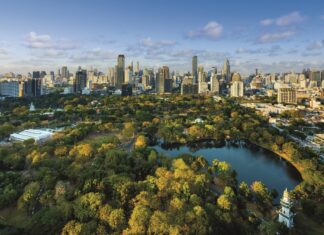The China Concept Wastewater Resource Facility received the prestigious Grand Innovation Award at IWA’s Project Innovation Awards Gala event in Toronto, Canada. We asked the team to explain what is so special about this project.
What is the Expert Committee for China’s Concept Wastewater Treatment Plants (CCWC) and what are its aims and objectives?
In early 2014, six prominent Chinese environmental experts, Jiuhui Qu, Kaijun Wang, Hongchen Wang, Gang Yu, Bing Ke, and Hanqing Yu, proposed constructing a futuristic urban wastewater treatment concept plant for China. Aimed at 2030-2040, their goal was to incorporate global best practices and advanced technologies to achieve ‘sustainable water quality, energy self-sufficiency, resource recovery, and environmental friendliness’. To support this vision, they formed the ‘Concept Plant Expert Committee’, which expanded to include nine members: Jiuhui Qu (Chair), Hongqiang Ren, Hanqing Yu, Gang Yu, Kaijun Wang, Hongchen Wang, Bing Ke, Xingcan Zheng, and Ji Li. Their mission is to create a concept plant surpassing current global standards by 20 years, transitioning China from a follower to a leader in wastewater treatment.
What are the key challenges for the Chinese water and wastewater sectors?
China has a large total water volume, yet per capita availability is low, at only about a quarter of the global average. Northern regions, in particular, face severe water scarcity. With rapid urbanisation and industrialisation China’s wastewater output has surged, giving it the world’s highest wastewater treatment volume, straining facilities near their operational limits.
A further challenge is the uniformity of national wastewater standards, which limit flexibility, particularly for economically underdeveloped regions, imposing high operational costs and resource waste in areas not sensitive to water issues.
Facilities face significant technical and financial challenges in upgrading to meet stricter standards, especially with the emergence of pollutants like pharmaceuticals and microplastics. In addition, many plants focus solely on pollutant removal, overlooking the potential to recover valuable resources from wastewater and sludge.
Wastewater treatment plants, particularly those using traditional processes, consume a large amount of energy and produce significant carbon emissions. There is a need for urgent energy and carbon reduction solutions if China is to meet its ‘dual carbon’ goals.
What are the most noteworthy aspects of the Yixing Concept Water Resource Reclamation Facility?
The Yixing plant uses anaerobic digestion to produce 3000 m3 of biogas daily, converted into 6000 kWh of electricity, reducing external energy dependency and lowering emissions.
Advanced purification technologies, such as ozone-UV disinfection for emerging pollutants, allow flexible upgrades, including mainstream Anammox (anaerobic ammonium oxidation) technology, for future water quality requirements.
Unlike traditional plants, Yixing transforms organic waste into products like nutrient-rich organic soil, reducing disposal pressure and supporting sustainable agriculture.
Innovative odour control, eco-friendly building designs, and community integration, minimise pollution and enhance biodiversity. In addition, the plant has engaged more than 50,000 community members in environmental education, raising awareness of sustainable water management, and its architectural design won an international award in 2023 for innovative health design.
What have been the key outcomes of the project?
Based on the water-energy-material recycling relationship in wastewater treatment, the concept plant redefines the mission of future wastewater treatment facilities, transforming the public’s perception and understanding of these plants. It conveys the message that wastewater is a resource, and wastewater treatment plants are resource plants.
The concept plant initiative has built five key technical systems to achieve water-energy-material regeneration:
- A Water Quality Safety System focusing on extreme nitrogen and phosphorus removal and the elimination of emerging pollutants.
- A Low-Carbon Technology System centred on processes such as fine filtration and sulphur-based autotrophy.
- A Regional Resource Synergy System using advanced dry anaerobic processing equipment.
- A Smart Management System based on digital twins and intelligent decision-making.
- An Eco-Complex Technology System that integrates elements of water quality, energy, resources and ecology.
The concept plant marks a milestone in China’s wastewater treatment industry, receiving recognition and support from industry stakeholders and spurring ongoing exploration and collaboration among government, industry, academia, and research sectors.
The Three Gorges Group plans to replicate the concept plant model along the Yangtze River over the next five years, implementing a chain-network model to create a series of innovative plants that will serve as effective tools for ecological management in the Yangtze region.
This project is supported by national key research and development funding, with the first implementation under way at the Fenghuangqiao Water Purification Plant in Lu’an, Anhui Province.
What are the future ambitions of the CCWC?
China’s concept plants will aim to meet stricter environmental requirements, focusing on new pollutants such as microplastics and pharmaceuticals. Further expansion of resource recovery will transform plants into resource producers rather than focusing solely on pollution control, and by advancing biomass energy technologies and reducing emissions, Yixing aims to support China’s ‘carbon peak’ and ‘carbon neutrality’ goals.
Future plants will increasingly rely on intelligent digital technologies to optimise resource use and energy efficiency. Our ambition is for China’s concept plant model and expertise to extend globally, aiding other regions in managing water resources and environmental protection challenges.
Future plants will integrate with their surroundings, incorporating eco-friendly architecture, green infrastructure, and community interaction, creating high-acceptance and environmentally friendly facilities.
Centred on a production-based R&D hub, it will bring together leading research talent to drive breakthroughs in core technologies, establishing itself as an incubator and prime site for cutting-edge applications, and through the demonstration of innovative technologies, the concept plant will continually enhance its treatment efficiency and resource recovery capabilities while also exporting advanced technological achievements across China and globally. This will further solidify its role as a benchmark technology demonstration base leading the future development of the industry.
Responses provided by Yifei Zhang, chairman of CSD Water Service Co, Changmin Wu, general manager of the Yixing Concept Plant, and Jifang Zhang, vice-general manager of the Yixing Concept Plant.
Read more about the IWA Project Innovation Awards at:
Global best in water projects announced at IWA 2024 Project Innovation Awards








